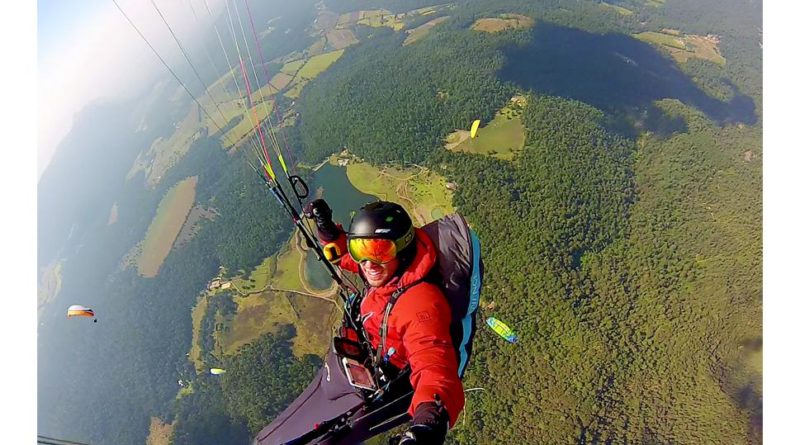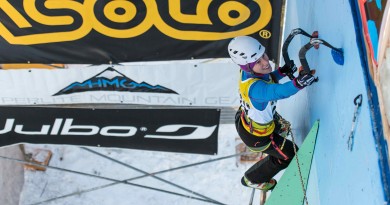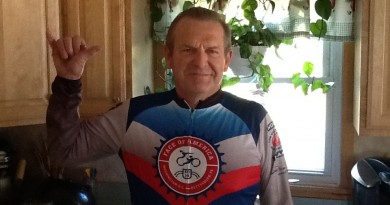Flight School With Calef Letorney
Name: Calef Letorney Age: 34 . Lives in: Westford
Family: Parents, Mark and Andrea; brother, Graham; dog, Homer Newton; kitten, Special Agent Lunchbox
Primary sports: Paragliding, whitewater kayaking, skiing:
Occupation: Vice-president at Rovers North; Paragliding instructor, Paraglide New England
Calef Letorney made a name for himself as a freestyle kayaker, but these days he’s traded the water for the sky. He owns Paraglide New England, located in Westford in northwestern Chittenden County, where he’s one of three flight instructors. While most people might think paragliding qualifies as an adrenaline sport, Letorney begs to differ, referring to it as “chess in the sky.”
Calef Letorned filmed his flight from West Rutland to New Haven.
How did you get into whitewater kayaking, your first sport?
I grew up in Westford. I got into kayaking because I saw a picture of a whitewater kayaker in a magazine. I was so intrigued! So, when I saw a whitewater kayaking summer camp at Clearwater Sports in Waitsfield, I had to go. After a few years on Clearwater trips, I went on an Adventure Quest summer camp trip to Canada. Westford didn’t have a high school so I decided to go to The Academy at Adventure Quest, which was in Brownsville, Vt.
Then how did you become a national champion?
At Adventure Quest, every semester we would travel to locations like Canada, Ecuador, New Zealand, Chile and Nepal. We lived in tents for months at a time and took turns cooking and cleaning. I started with the slalom kayaking group and the next year switched to freestyle kayaking, known as “rodeo.” Kayaking over 200 days a year, I got good quickly. I made the U.S. team three times, was National Champion twice and went to the World Championships in 2001. I was in Boulder in 2005 when I learned that you could hike to launch and soar for hours on a wing made of nylon and dental floss. Within a few days I had found an instructor and started taking lessons.
How long until you got good?
At the training hill you learn to launch and land, but then it takes years to learn what to do in between; how to soar with the birds. I moved back to Vermont in January of 2007. At that time, I was already an advanced pilot and so I was able to fly the established Vermont Hang Gliding Association sites at West Rutland and Burke. Later we started flying Sugarbush and a few other sites including Mont Yamaska in Quebec. In 2010 I got my USHPA Tandem License at Morningside Park, in New Hampshire. That same year, I started teaching pilots who had graduated from a training hill how to fly the bigger, more complicated Vermont mountain sites, such as Burke. I wanted to fly with other people skilled enough to launch from a mountain site in the middle of the day, hook a thermal which is a column of rising air, climb to 500 feet below cloud base (the legal limit) and then fly for four to five hours. Since paraglider pilots of that skill level didn’t really reside in Vermont, I figured I needed to teach them myself.
Below, a graphic shows one of Calef’s longest flights on July 8, 2018 —one of the five longest he’s done. Letorney flew 37 miles, launching from a spot near Rutland.
How did you end up starting a paragliding school?
I started teaching ski buddies and hang-glider pilots. I was building a crew of solid flying buddies and it was working. A few years ago, I founded the Vultures, which we describe as a “fake flying club that does real flying.” Fake because we don’t have dues or control launch sites; it’s just a group of 60 pilots sharing our flying plans. Then I met my business partners, Paul Somerset and Ryan Dunn, and the idea of a full-fledged paragliding school came together.
How did they get involved?
One day Paul called me up—he was a friend of a friend. After moving to Vermont to recuperate from a wingsuit BASE jumping accident, he missed acrobatic paragliding. So he bought a boat and a winch with 6,500 feet of line with the goal of towing people on Lake Champlain, so they could get up to 4,500 feet in the air. It was paraglider Christmas for me. I tapped into the Vultures and in no time, we were having a ball towing the lake. It didn’t take long before we realized we had created a liability nightmare and the only solutions were to stop towing or form a corporation, so we could buy commercial liability insurance. Founding a flight school just made sense since I was already doing the solo and tandem instruction and leading guided trips to Mexico. Paul had been an USHPA Certified Advanced Instructor since the early 1990s. I knew the two of us couldn’t do it alone so I convinced Ryan Dunn to join the venture. Ryan had sold his business a handful of years earlier, and quickly became addicted to paragliding
Where do you teach in Vermont?
We teach at West Rutland, Burke and Mont Yamaska, in southern Quebec. Novices start in calm conditions in the morning and evening and as their skills progress they work up to soaring in the middle of the day when the thermals are stronger. My favorite site is Burke as quite often it yields thermals up to 6,500 feet and it’s a straight shot down I-91 following the Connecticut River Valley. It’s a great cross-country route. Sugarbush is the biggest and most impressive mountain we fly, but it needs light easterly or northeasterly winds, which are rare.
With all the complications, is teaching paragliding still fun?
Definitely! I could not think of a better excuse to be out flying. It never went over well with friends or family when I declined to attend BBQs, graduation parties, family reunions or whatever to go flying. ‘Sorry, I have to work. I’m teaching paragliding‘ is so much more acceptable. Plus, I really enjoy instructing novice and intermediates in mountain soaring.
Tracking the flight from West Rutland to New Haven.
How do you teach from the air?
On days we are soaring in the mountains, I launch with the students and coach them over the radio while we fly together. I’m like Mother Goose guiding them on an adventure as we spend hours circling in thermals to gain altitude. We glide until we find the next thermal and repeat over and over until we sink out and land. That’s nice work if you can get it. And it just tickles me that some of my students are now surpassing me. One went to India this spring and flew 100 miles in the Himalayas. I haven’t done a 100-mile flight yet.
What’s the longest flight you have done in Vermont?
I’ve flown for 4 hours and 45 minutes and covered about 72 kilometers gliding from Burke to south of Haverhill, N.H. A year earlier that would have been a state record, but there are some super good pilots from the Boston area that keep coming up and breaking the record. The current state record is 90K and that won’t last long. I’m confident that with the right day I could do 100K easy. We had a day this spring, with 10,000-foot cloud base and a bit of wind… but I was sitting in my office doing my real job. Maybe someday the stars will align. Either way the chase is incredible.
How does paragliding compare with whitewater kayaking?
Flying the world’s slowest aircraft through a torrent of air in the mountains is a good bit like kayaking in river currents, but the goals and intensities of the sports are very different. Paragliding is a slow, meditative chess game in the sky, played in a relaxed, reclined position. On a paraglider, we can’t flap and there’s no motor, so we can only extend our flight time by surfing rising air currents. This takes knowledge, skill, intuition, and patience. Altitude is fuel in the tank, so we get as high as possible. Since it’s the ground that hurts, our constant search for altitude is also a continuous effort to increase safety margins. That’s a good bit different from whitewater kayaking, where the name of the game is to paddle down the most challenging rapids possible on the ragged edge of control.
—Phyl Newbeck




Pingback: 7 New Thrill Sports You Can Learn This Summer - Vermont Sports Magazine